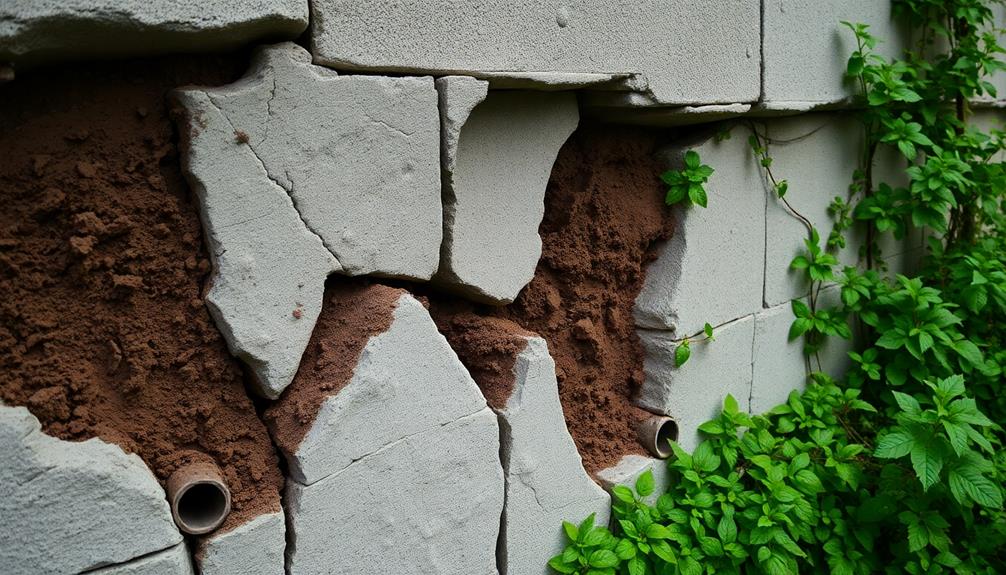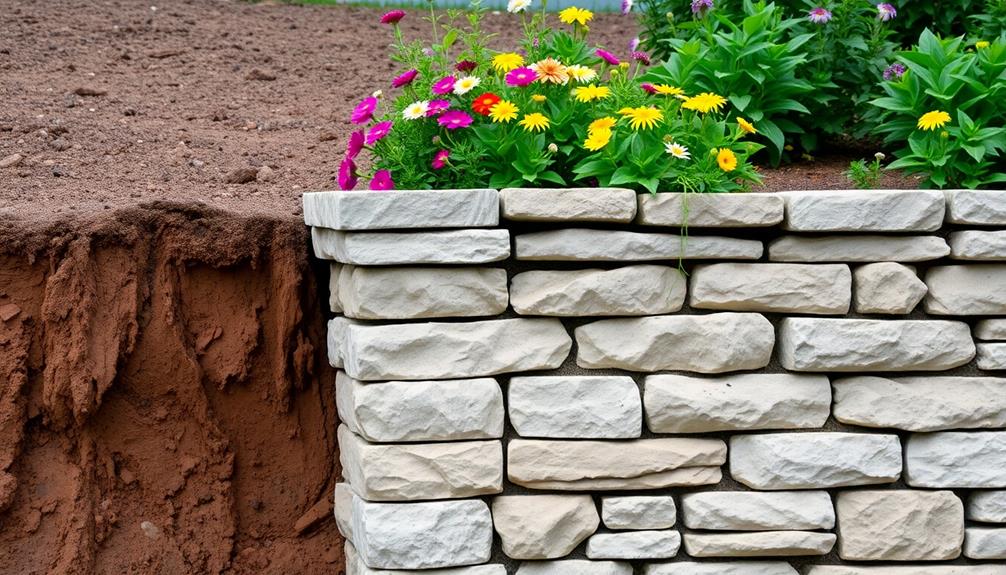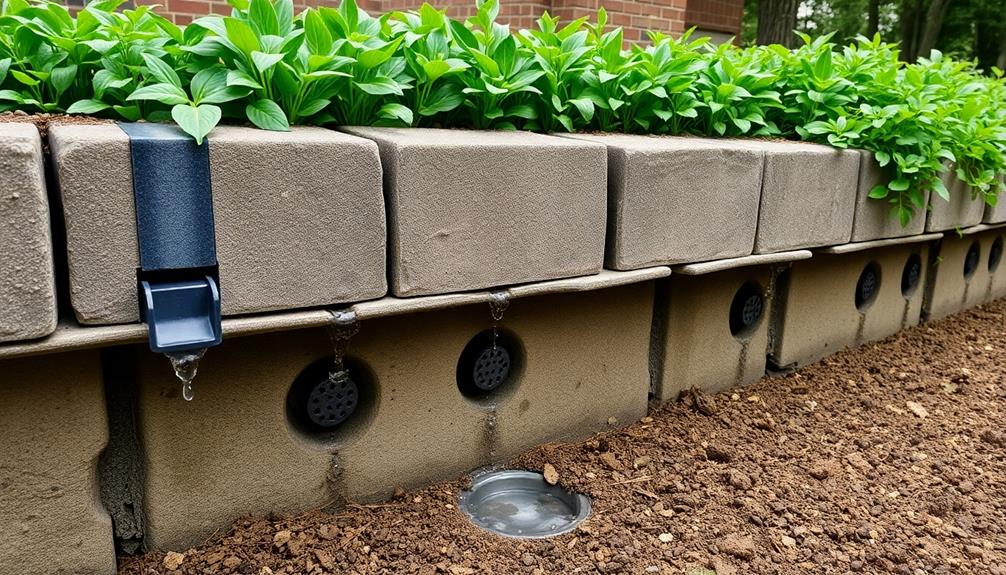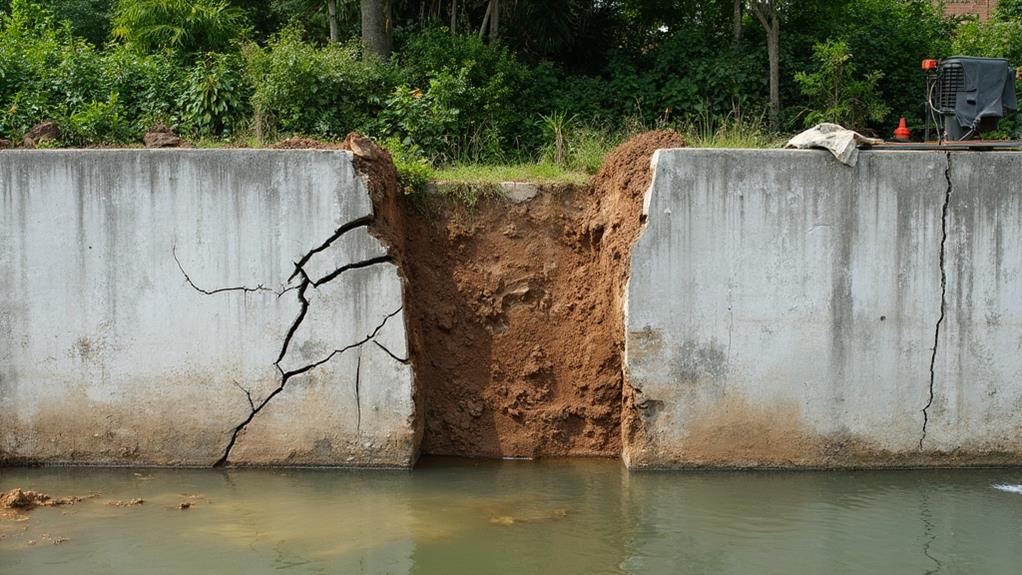Retaining walls commonly face structural integrity issues, including bulging, leaning, cracking, and drainage system failures. Improper soil compaction, inadequate wall construction, and insufficient drainage often lead to these problems. Soil erosion, subsidence, and weather-related deterioration can exacerbate structural weaknesses. Solutions involve improving drainage systems, reinforcing wall structures, and addressing soil stabilization. Regular inspections and prompt remediation are indispensable to prevent wall collapse. Proper construction techniques, appropriate material selection, and effective water management are essential for long-term wall stability. Understanding these issues and their remedies is pivotal for maintaining the functionality and safety of retaining walls in various landscapes and property settings.
Table of Contents
ToggleWalls Contractor Highlights
- Structural integrity issues like bulging or leaning can be fixed with additional support structures or wall reconstruction.
- Drainage problems, including clogged systems, can be resolved by cleaning or installing new drainage pipes and weep holes.
- Soil erosion and subsidence issues require proper vegetation, soil stabilization techniques, and addressing underground water sources.
- Cracking and deterioration can be prevented by using quality materials, adding expansion joints, and protecting against freeze-thaw cycles.
- Improper soil compaction and wall construction problems may necessitate partial rebuilding or reinforcement of the wall and foundation.
Structural Integrity of Retaining Walls

The structural integrity of retaining walls is essential for their long-term performance and safety, with several key indicators signaling potential issues. Wall bulging or leaning, cracks and fractures, and drainage system failures are among the most common problems that can compromise a retaining wall's stability and effectiveness. Implementing landscape design expertise during construction can mitigate these risks and enhance both the functional and visual purposes of the wall.
These issues, if left unaddressed, can lead to significant structural damage, soil erosion, and even complete wall collapse, highlighting the importance of regular inspections and prompt remediation efforts.
Wall Bulging or Leaning
Bulging or leaning retaining walls signal serious structural integrity issues that require immediate attention. These deformations often result from excessive soil pressure, inadequate drainage, or poor construction techniques. As homeowners and property managers, we must recognize the importance of addressing these issues promptly to prevent catastrophic failure and guarantee the safety of our communities.
To rectify a bulging or leaning retaining wall, a thorough assessment is necessary. This evaluation typically involves soil testing, structural analysis, and examination of drainage systems. Based on the findings, solutions may include installing additional support structures, such as anchors or tiebacks, to counteract soil pressure. Improving drainage through the implementation of weep holes or French drains can alleviate hydrostatic pressure, which often contributes to wall deformation. In severe cases, partial or complete reconstruction of the wall may be required, incorporating proper engineering principles and high-quality materials to ensure long-term stability. By addressing these issues proactively, we not only protect our investments but also contribute to the overall safety and aesthetic appeal of our neighborhoods.
Cracks and Fractures
Beneath the surface of a seemingly stable retaining wall, cracks and fractures can silently compromise its structural integrity. These defects, often imperceptible to the untrained eye, can develop due to various factors including soil pressure, water infiltration, and inadequate construction techniques. As members of a community invested in the longevity of our infrastructure, it's indispensable to recognize the signs and implications of these structural issues.
Cracks may manifest as hairline fissures or more substantial separations, typically running vertically or diagonally across the wall face. Horizontal cracks are particularly concerning, as they may indicate imminent failure. Fractures can occur at weak points such as corners or joints, potentially leading to sections of the wall separating entirely. To address these problems, a thorough assessment by a qualified engineer is essential.
Solutions may involve injecting epoxy into smaller cracks, applying carbon fiber reinforcement for larger fissures, or in severe cases, partial or complete reconstruction of the affected areas. By proactively identifying and remedying cracks and fractures, we guarantee the continued stability and safety of our retaining walls, preserving both property value and community well-being.
Drainage System Failures
While cracks and fractures pose considerable risks to retaining walls, another critical issue that can compromise their structural integrity is drainage system failure. Proper drainage is essential for maintaining the stability and longevity of retaining walls, as it prevents the buildup of hydrostatic pressure behind the structure.
When drainage systems malfunction, water accumulates in the soil, leading to increased lateral pressure and potential wall failure.
Common causes of drainage system failures include clogged weep holes, damaged or incorrectly installed drainage pipes, and inadequate grading around the wall. These issues can result in soil erosion, settlement, and ultimately, wall collapse.
To address drainage problems, homeowners and contractors should regularly inspect and clean weep holes, ensuring they remain unobstructed. Additionally, implementing an extensive drainage solution, such as installing a perforated pipe system wrapped in geotextile fabric, can effectively channel water away from the wall's foundation. Proper grading techniques, including creating a slight slope away from the wall, further enhance drainage efficiency.
Benefits

Retaining walls offer numerous advantages that extend beyond their primary function of soil retention. These structures can vastly increase property value by creating visually appealing landscapes and maximizing usable outdoor space, while simultaneously providing essential soil stabilization and erosion control.
Additionally, they can be constructed from various materials such as limestone, which enhances the aesthetic appeal and provides durability and weather resistance. Moreover, well-designed retaining walls play a pivotal role in water management, effectively redirecting surface runoff and preventing water-related damage to foundations and surrounding areas.
Increased Property Value
Although often overlooked, a well-constructed retaining wall can considerably boost a property's value. These structures not only serve practical purposes but also contribute to the overall aesthetic appeal and functionality of a landscape. By effectively managing soil erosion and creating usable space on sloped terrain, retaining walls enhance the property's potential for landscaping and outdoor living areas. This increased usability translates directly into higher property valuations, as potential buyers recognize the added benefits and versatility of the land.
Furthermore, a professionally designed and installed retaining wall demonstrates a commitment to property maintenance and improvement. This can instill confidence in prospective buyers or appraisers, potentially leading to higher offers or valuations. The added curb appeal created by an attractive retaining wall can also make a property stand out in a competitive real estate market. Additionally, by mitigating potential soil stability issues, these structures can reduce long-term maintenance costs and liabilities associated with erosion or landslides. This enhanced safety profile and reduced risk factor can be particularly appealing to insurance companies and mortgage lenders, potentially resulting in more favorable terms for property owners.
Enhanced Outdoor Living Space
Beyond the financial benefits, retaining walls offer significant improvements to outdoor living spaces. These structures create level areas in sloped terrain, expanding usable land for various outdoor activities. Homeowners can transform previously unusable slopes into functional patios, gardens, or seating areas, enhancing the overall enjoyment of their property.
Retaining walls also provide opportunities for creative landscaping designs. By incorporating built-in planters or terraced gardens, they add visual interest and depth to outdoor spaces. These features can be customized to complement the home's architecture and personal style preferences, creating a cohesive and attractive outdoor environment.
Additionally, retaining walls can be utilized to define separate areas within a yard, such as delineating a play area from a dining space or creating intimate nooks for relaxation. The added structure and organization contribute to a more inviting and versatile outdoor living area. Consequently, by maximizing the usable space on a property, retaining walls allow homeowners to fully leverage their outdoor areas, potentially reducing the need for interior additions and encouraging a stronger connection with nature.
Improved Soil Stabilization
Soil erosion poses a significant threat to property integrity, but retaining walls offer an effective solution for improved soil stabilization. These structures provide a robust defense against the relentless forces of nature, preventing soil displacement and maintaining the structural integrity of landscapes. By implementing a well-designed retaining wall, property owners can substantially reduce the risk of landslides, soil subsidence, and other erosion-related issues that may compromise the safety and value of their land.
Retaining walls accomplish soil stabilization through various mechanisms. They redistribute the lateral earth pressure, effectively holding back soil masses and preventing downslope movement. This is particularly pivotal in areas with steep gradients or unstable soil compositions. Additionally, these structures facilitate proper drainage, directing water away from vulnerable soil areas and minimizing the potential for water-induced erosion. The enhanced stability provided by retaining walls also allows for the cultivation of vegetation on otherwise precarious slopes, further reinforcing soil cohesion through root systems. Ultimately, the implementation of retaining walls as a soil stabilization measure not only protects property but also contributes to the overall ecological balance of the landscape.
Better Water Management
Effective water management stands as a paramount benefit of well-designed retaining walls. These structures play a pivotal role in mitigating soil erosion, preventing water accumulation, and safeguarding property integrity. By implementing superior drainage systems, retaining walls efficiently channel water away from vulnerable areas, reducing the risk of soil saturation and subsequent instability. This proactive approach not only extends the lifespan of the wall itself but also protects surrounding landscapes and structures from potential water damage.
Incorporating proper water management techniques into retaining wall design involves the strategic placement of weep holes, the installation of perforated drain pipes, and the use of granular backfill materials. These elements work in concert to facilitate the controlled movement of water, preventing hydrostatic pressure buildup behind the wall. Additionally, the integration of swales or catch basins at the base of the wall can further enhance water diversion capabilities, ensuring that excess runoff is directed to appropriate drainage outlets. By embracing these advanced water management solutions, property owners can drastically reduce maintenance requirements, minimize the risk of structural failure, and create a more resilient and sustainable landscape environment.
Proper Drainage System Installation

A proper drainage system is essential for the longevity and stability of retaining walls. To achieve optimal drainage, it is vital to install drainage pipes, use appropriate backfill material, and incorporate weep holes into the wall's design. The following table outlines key considerations for each of these critical drainage components:
| Component | Purpose | Best Practices | Common Materials | Maintenance |
|---|---|---|---|---|
| Drainage Pipes | Redirect water away from wall | Install behind wall at regular intervals | Perforated PVC or corrugated pipe | Regular cleaning and inspection |
| Backfill Material | Allow water to flow freely | Use clean, granular material | Gravel or crushed stone | Periodic compaction check |
| Weep Holes | Allow water to exit wall face | Space evenly along wall base | PVC pipe or preformed inserts | Clear debris regularly |
| Filter Fabric | Prevent soil erosion | Place between soil and backfill | Geotextile fabric | Replace if damaged |
| Slope Grading | Direct surface water away | Create positive slope from wall | N/A | Maintain proper grade over time |
Install Drainage Pipes
Proper installation of drainage pipes is paramount to the longevity and effectiveness of any retaining wall system. These pipes serve as indispensable conduits for redirecting water away from the wall's foundation, preventing hydrostatic pressure buildup that can lead to structural instability.
When installing drainage pipes, it is essential to use perforated pipes with a minimum diameter of 4 inches, positioned at the base of the wall and surrounded by a layer of gravel or crushed stone. The pipes should be laid with a slight downward slope, typically 1/4 inch per foot, to guarantee proper water flow. It is advisable to wrap the pipes in a geotextile fabric to prevent soil particles from clogging the perforations.
The drainage system should extend beyond the ends of the wall and discharge water at a safe distance from the structure. Regular maintenance, including periodic inspection and cleaning of the pipes, is indispensable to maintain ideal performance. By implementing a well-designed drainage pipe system, property owners can considerably reduce the risk of water-related damage to their retaining walls, ensuring the longevity and stability of these essential landscape features.
Use Proper Backfill Material
Selecting appropriate backfill material is essential for guaranteeing the stability and longevity of retaining walls. The choice of backfill can drastically impact the wall's performance, drainage capabilities, and overall structural integrity.
Ideal backfill materials include well-graded, granular soils such as crushed stone, gravel, or sand. These materials provide excellent drainage properties and reduce the hydrostatic pressure behind the wall.
When selecting backfill, it's indispensable to avoid clay-rich soils, organic matter, or any materials that retain excessive moisture. These unsuitable materials can lead to increased lateral pressure, compromising the wall's stability over time.
Additionally, proper compaction of the backfill is paramount. Each layer should be compacted to the appropriate density, typically 95% of the maximum dry density, to prevent settlement and ensure uniform load distribution.
Homeowners and contractors alike should be aware that using the correct backfill material not only enhances the wall's performance but also contributes to its longevity, potentially saving considerable costs in future repairs or replacements. By adhering to these backfill guidelines, property owners can protect their investment and maintain a safe, functional retaining wall for years to come.
Incorporate Weep Holes
Incorporating weep holes and a proper drainage system is essential for maintaining the structural integrity of retaining walls. Without adequate drainage, hydrostatic pressure can build up behind the wall, leading to potential failure. Weep holes allow water to exit, reducing this pressure and preventing moisture-related issues such as erosion and frost heave.
A well-designed drainage system typically includes a perforated pipe at the base of the wall, surrounded by gravel or crushed stone, which directs water away from the structure.
To guarantee effective drainage, consider the following steps:
- Install weep holes at regular intervals along the base of the wall
- Place a layer of gravel or crushed stone behind the wall to facilitate water movement
- Incorporate a perforated drain pipe at the base, sloped to direct water away from the wall
- Use a geotextile fabric to prevent soil from clogging the drainage system
Walls Contractor FAQ
How Often Should Retaining Walls Be Inspected for Potential Issues?
Retaining walls should be inspected annually by homeowners and every 2-3 years by professionals. Regular checks help identify issues early, ensuring the safety and longevity of your property. Join the community of proactive homeowners by scheduling inspections today.
Can Plants or Trees Be Safely Planted Near Retaining Walls?
Planting near retaining walls can be done safely with careful consideration. Choose shallow-rooted plants and maintain a proper distance to avoid root damage. Consult a landscaper for guidance on suitable species and placement to enhance your outdoor space.
What Materials Are Best for Constructing Long-Lasting Retaining Walls?
Durable materials for retaining walls include:
- Reinforced concrete
- Natural stone
- Interlocking concrete blocks
- Pressure-treated timber
These options offer strength and longevity, ensuring your wall remains sturdy for years. Choose based on your budget and aesthetic preferences.
Are Permits Required for Building or Repairing Retaining Walls?
Permits for retaining walls are often required, depending on local regulations and wall height. It's best to consult your city's building department to guarantee compliance. This step demonstrates responsible homeownership and community-mindedness.
How Do Freeze-Thaw Cycles Affect Retaining Wall Stability and Maintenance?
Freeze-thaw cycles can greatly impact retaining wall stability by causing soil expansion and contraction. This process may lead to cracking, shifting, or bulging in the wall structure. Regular inspections and proper drainage are essential for maintaining wall integrity.







